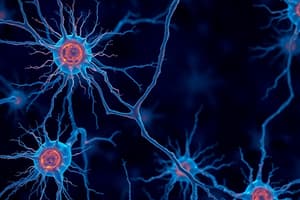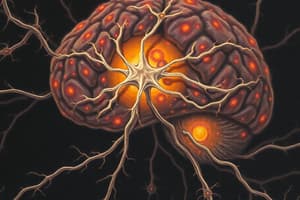Podcast
Questions and Answers
What is the primary function of the somatic division of the PNS?
What is the primary function of the somatic division of the PNS?
- Involuntary control (e.g., heart rate)
- Filtering waste products from blood
- Voluntary control (e.g., moving your arm) (correct)
- Secreting enzymes for digestion
Which type of glial cell forms myelin in the CNS?
Which type of glial cell forms myelin in the CNS?
- Schwann Cells
- Oligodendrocytes (correct)
- Astrocytes
- Microglia
What is the main function of the axon hillock?
What is the main function of the axon hillock?
- Processing signals
- Forming myelin sheath
- Receiving signals from other neurons
- Initiating action potentials (correct)
Which direction does anterograde transport move materials?
Which direction does anterograde transport move materials?
What is white matter primarily composed of?
What is white matter primarily composed of?
Which type of neuron carries information towards the CNS?
Which type of neuron carries information towards the CNS?
What is the role of microglia in the nervous system?
What is the role of microglia in the nervous system?
Which of the following describes an action potential?
Which of the following describes an action potential?
What type of ion channel opens at the axon hillock when the threshold is reached, initiating an action potential?
What type of ion channel opens at the axon hillock when the threshold is reached, initiating an action potential?
What is the primary function of voltage-gated potassium channels during an action potential?
What is the primary function of voltage-gated potassium channels during an action potential?
What is the key characteristic of the absolute refractory period?
What is the key characteristic of the absolute refractory period?
Which of the following axon characteristics leads to faster signal conduction?
Which of the following axon characteristics leads to faster signal conduction?
What is the role of myelin in neuronal signal transmission?
What is the role of myelin in neuronal signal transmission?
What type of ion channel opens to trigger neurotransmitter release at the synapse?
What type of ion channel opens to trigger neurotransmitter release at the synapse?
Which of the following would increase the strength of a synaptic signal?
Which of the following would increase the strength of a synaptic signal?
What cells produce cerebrospinal fluid (CSF)?
What cells produce cerebrospinal fluid (CSF)?
In which lobe of the brain is the primary motor cortex located?
In which lobe of the brain is the primary motor cortex located?
What is the main function of the cerebral arterial circle (Circle of Willis)?
What is the main function of the cerebral arterial circle (Circle of Willis)?
Flashcards
Sensation
Sensation
Detects environmental changes.
Integration
Integration
Processes sensory information to make decisions.
Motor Output
Motor Output
Activates muscles or glands to respond.
CNS
CNS
Signup and view all the flashcards
PNS
PNS
Signup and view all the flashcards
Somatic Division
Somatic Division
Signup and view all the flashcards
Autonomic Division
Autonomic Division
Signup and view all the flashcards
Astrocytes
Astrocytes
Signup and view all the flashcards
Voltage-Gated Sodium Channels
Voltage-Gated Sodium Channels
Signup and view all the flashcards
Voltage-Gated Potassium Channels
Voltage-Gated Potassium Channels
Signup and view all the flashcards
Absolute Refractory Period
Absolute Refractory Period
Signup and view all the flashcards
Saltatory Conduction
Saltatory Conduction
Signup and view all the flashcards
Voltage-Gated Calcium Channels
Voltage-Gated Calcium Channels
Signup and view all the flashcards
Excitatory Synapses
Excitatory Synapses
Signup and view all the flashcards
Inhibitory Synapses
Inhibitory Synapses
Signup and view all the flashcards
Ependymal Cells
Ependymal Cells
Signup and view all the flashcards
Gyri and Sulci
Gyri and Sulci
Signup and view all the flashcards
Primary Motor Cortex
Primary Motor Cortex
Signup and view all the flashcards
Study Notes
Nervous System Functions
- Sensation involves detecting internal and external environmental changes.
- Integration processes sensory information for decision-making.
- Motor output activates muscles or glands for appropriate responses.
CNS vs. PNS
- The CNS includes the brain and spinal cord, and does integration and processing.
- The PNS consists of nerves extending from the CNS, handling sensory input and motor output.
PNS Divisions
- The somatic division controls voluntary actions, like moving an arm.
- The autonomic division controls involuntary actions, such as heart rate and digestion.
Glial Cells
- Glial cells support neurons and are necessary for their function, but do not transmit electrical signals.
- Astrocytes support neurons and maintain the blood-brain barrier.
- Oligodendrocytes form myelin in the CNS
- Schwann cells form myelin in the PNS
- Microglia provide immune defense in the CNS
- Ependymal cells produce cerebrospinal fluid (CSF).
Axonal Transport
- Anterograde transport moves materials from the soma to the axon terminal.
- Retrograde transport moves materials from the axon terminal to the soma.
- These processes are necessary for nutrient and waste transport.
Neuron Structure and Function
- Dendrites receive signals.
- The cell body processes signals.
- The axon transmits action potentials.
- The axon hillock initiates action potentials.
White vs. Gray Matter
- White matter is composed of myelinated axons.
- Gray matter is composed of neuron cell bodies and dendrites.
Neuron Structural Classes
- Multipolar neurons have many dendrites and one axon, and are common in the CNS.
- Bipolar neurons have one dendrite and one axon, and are found in the retina.
- Unipolar neurons have a single process that splits, and are found in sensory neurons.
Neuron Functional Classes
- Sensory (afferent) neurons carry information to the CNS.
- Motor (efferent) neurons carry information from the CNS.
- Interneurons connect sensory and motor neurons.
Reflex Arc Example - Finger Prick
- Sensory neurons detect pain, interneurons process the signal, and motor neurons signal muscle withdrawal.
Digestive System Example - Eating
- The parasympathetic division of the autonomic nervous system triggers enzyme secretion.
Graded vs. Action Potentials
- Graded potentials are analog and vary in strength.
- Action potentials are digital and all-or-nothing.
Action Potential Initiation
- Voltage-gated sodium channels at the axon hillock open when the threshold is reached.
Action Potential Propagation
- Sodium influx depolarizes the membrane, opening adjacent channels down the axon.
Repolarization
- Voltage-gated potassium channels open, allowing potassium to exit and repolarize the membrane.
Reduced Potassium Channels
- Reduced number of potassium channels result in slower repolarization and prolonged action potentials.
Refractory Periods
- During the absolute refractory period, sodium channels are inactivated, preventing new action potentials.
- During the relative refractory period, an action potential is possible but requires a stronger stimulus.
No Absolute Refractory Period
- Absence of an absolute refractory period could to continuous action potentials and overstimulation.
Axon Properties and Speed
- Longer and larger axons conduct signals faster.
Myelination
- Myelin insulates axons, enabling faster saltatory conduction.
When to Avoid Myelination
- Short-distance signaling, such as in local interneurons, might not need myelination.
Neurotransmitters
- Neurotransmitters are chemicals released at synapses that influence post-synaptic neurons.
- Dopamine is a neurotransmitter for reward.
- Serotonin is a neurotransmitter for mood.
Action Potential Detection
- Voltage-gated calcium channels open to trigger neurotransmitter release.
Vesicle Recycling
- Vesicles fuse with the membrane, release neurotransmitters, and are recycled.
Neurotransmitter Strength
- The strength of neurotransmitter signals depends on the amount released and receptor sensitivity.
Synapse Types
- Excitatory synapses increase sodium influx (depolarization).
- Inhibitory synapses increase potassium or chloride influx (hyperpolarization).
Electrical Synapses
- Electrical synapses would prevent signal modulation and integration.
Frequency and Synaptic Activity
- Higher action potential frequency increases neurotransmitter release.
CSF Production
- CSF is produced by ependymal cells in the choroid plexus.
CSF Flow
- CSF flows from the lateral ventricles to the third ventricle, then to the cerebral aqueduct, to the fourth ventricle, to the subarachnoid space, to the dural sinuses, and finally into the blood.
Gyri and Sulci Purpose
- Gyri (ridges) and sulci (grooves) increase the surface area of the brain, allowing for more neurons.
Voluntary Motor Control
- The primary motor cortex in the frontal lobe controls voluntary motor functions.
Insula Location
- The insula is located deep within the lateral sulcus.
Brain Lateralization
- The left hemisphere handles language and logic.
- The right hemisphere handles creativity and spatial abilities.
Brain Nuclei
- A nucleus is a cluster of neurons in the CNS.
- A ganglion is the equivalent structure in the PNS.
Cerebral Arterial Circle
- The cerebral arterial circle ensures consistent blood flow to the brain.
Cerebral Lobes and Functions
- The frontal lobe controls motor functions, planning, and mood.
- The parietal lobe processes sensory information.
- The occipital lobe processes visual information.
- The temporal lobe processes sound, smell, and memory.
White vs. Gray Matter
- White matter consists of myelinated axons and is located in the interior of the cortex.
- Gray matter consists of cell bodies and dendrites and is located in the outer cortex.
Brain Tracts
- Association tracts connect regions within one hemisphere.
- Commissural tracts connect the two hemispheres.
- Projection tracts connect different brain regions.
Motor Cortex Functions
- The primary motor cortex executes movements.
- The premotor cortex plans and coordinates movements.
Homunculus Map
- The size of body parts on the homunculus map reflects the density of sensory/motor neurons in those regions.
Studying That Suits You
Use AI to generate personalized quizzes and flashcards to suit your learning preferences.





